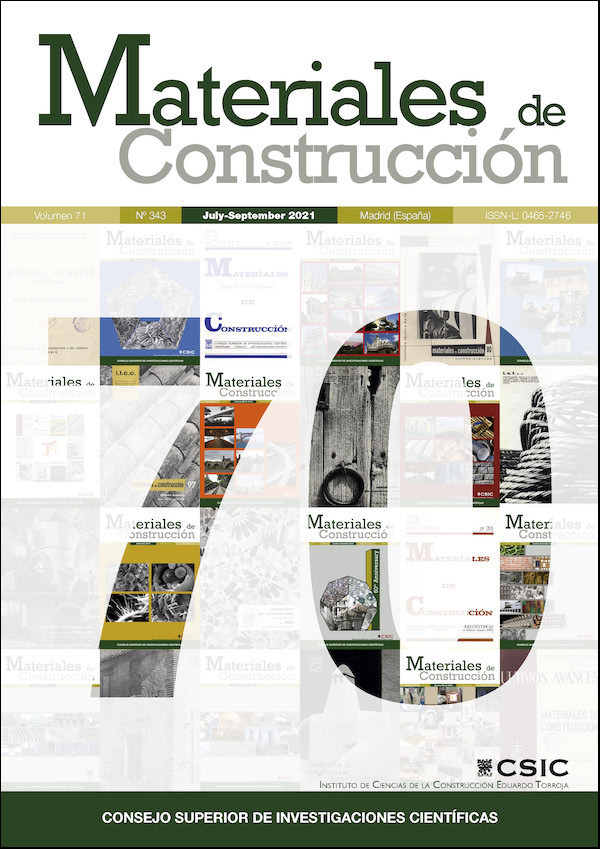Sustitución de áridos por arena de fundición residual: efectos sobre las propiedades físicas de morteros
DOI:
https://doi.org/10.3989/mc.2021.10320Palabras clave:
Tratamiento de residuos, Puzolana, Árido, Mortero, Resistencia a la CompresiónResumen
Se estudió la sustitución del árido normalizado por arena de fundición residual (WFS) sobre las propiedades físicas de morteros mediante ensayos de resistencia a la compresión y absorción capilar. El agregado fue reemplazado por WFS en su estado natural (WFS), arena de fundición residual lavada (WFSW) y arena de fundición residual tratada térmicamente (WFST). La WFS tenía porcentaje de bentonita, que se buscó activar térmicamente. Se encontró que el comportamiento físico de los morteros que contienen WFS y WFSW, fue similar al de la muestra control. A la arcilla recuperada del lavado de arena se le evaluó su potencial puzolánico, se encontró que, con el tratamiento térmico, la montmorillonita adquiere comportamiento puzolánico. Los morteros con WFST, presentaron una caída en la resistencia a la compresión. El efecto puzolánico logrado en la arcilla no se reflejó en la resistencia a la compresión de los morteros con WFST.
Descargas
Citas
Bhardwaj, B.; Kumar, P. (2017) Waste foundry sand in concrete: A review. Constr. Build. Mat. 156, 661-674. https://doi.org/10.1016/j.conbuildmat.2017.09.010
Tiwari, A.; Singh, S.; Nagar, R. (2016) Feasibility assessment for partial replacement of fine aggregate to attain cleaner production perspective in concrete: A review. J. Clean. Prod. 135, 490-507. https://doi.org/10.1016/j.jclepro.2016.06.130
Verian, K.P.; Ashraf, W.; Cao, Y. (2018) Properties of recycled concrete aggregate and their influence in new concrete production. Resour. Conserv. Recy. 133, 30-49. https://doi.org/10.1016/j.resconrec.2018.02.005
Serrano Guzmán, M.F.; Ruiz, D.D.P. (2011) Concreto preparado con residuos industriales: resultado de alianza empresa universidad. Rev. Edu. Ing. 6 [11], 1-11. Retrieved from http://www.educacioneningenieria.org/index.php/edi/article/view/116.
Dash, M.K.; Patro, S.K.; Rath, A.K. (2016) Sustainable use of industrial-waste as partial replacement of fine aggregate for preparation of concrete - A review. Int. J. Sustain. Built Environ. 5 [2], 484-516. https://doi.org/10.1016/j.ijsbe.2016.04.006
Basar, H.M.; Deveci Aksoy, N. (2012) The effect of waste foundry sand ( WFS ) as partial replacement of sand on the mechanical, leaching and micro-structural characteristics of ready-mixed concrete. Constr. Build. Mat. 35, 508-515. https://doi.org/10.1016/j.conbuildmat.2012.04.078
Ganesh Prabhu, G.; Hyun, J.H.; Kim, Y.Y. (2014) Effects of foundry sand as a fine aggregate in concrete production. Constr. Build. Mat. 70, 514-521. https://doi.org/10.1016/j.conbuildmat.2014.07.070
Fiore, S.; Zanetti, M.C.; Duca, C. (2007) Foundry wastes reuse and recycling in concrete production. Am. J. Environ. Sci. 3 [3], 135-142. https://doi.org/10.3844/ajessp.2007.135.142
Siddique, R.; Aggarwal, Y.; Aggarwal, P.; Kadri, E.H.; Bennacer, R. (2011) Strength, durability, and micro-structural properties of concrete made with used-foundry sand (UFS) Constr. Build. Mat. 25 [4], 1916-1925. https://doi.org/10.1016/j.conbuildmat.2010.11.065
Aggarwal, Y.; Siddique, R. (2014) Microstructure and properties of concrete using bottom ash and waste foundry sand as partial replacement of fine aggregates. Constr. Build. Mat. 54, 210-223. https://doi.org/10.1016/j.conbuildmat.2013.12.051
Naik, B.T.R. (1994) Utilization of used foundry sand in concrete. J. Mater. Civ. 6 [2], 254-263. https://doi.org/10.1061/(ASCE)0899-1561(1994)6:2(254)
Naik, F. (2012) Effects of fly ash and foundry sand on performance of architectural precast concrete. J. Mater. Civ. Eng. 24, 851-859. https://doi.org/10.1061/(ASCE)MT.1943-5533.0000432
Guney, Y.; Sari, Y.D.; Yalcin, M.; Tuncan, A.; Donmez, S. (2010) Re-usage of waste foundry sand in high-strength concrete. J. Waste Manag. 30 [8-9], 1705-1713. https://doi.org/10.1016/j.wasman.2010.02.018 PMid:20219339
Singh, G.; Siddique, R. (2012) Effect of waste foundry sand (WFS) as partial replacement of sand on the strength , ultrasonic pulse velocity and permeability of concrete. Constr. Build. Mat. 26 [1], 416-422. https://doi.org/10.1016/j.conbuildmat.2011.06.041
Prabhu, G.G.; Bang, J.W.; Lee, B.J.; Hyun, J.H.; Kim, Y. Y. (2015) Mechanical and durability properties of concrete made with used foundry sand as fine aggregate. Adv. Mater. Sci. Eng. 2015. https://doi.org/10.1155/2015/161753
Etxeberria, M.; Pacheco, C.; Meneses, J.M.; Berridi, I. (2010) Properties of concrete using metallurgical industrial by-products as aggregates. Constr. Build. Mat. 24 [9], 1594-1600. https://doi.org/10.1016/j.conbuildmat.2010.02.034
Sahmaran, M.; Lachemi, M.; Erdem, T.K.; Yu, H.E. (2011) Use of spent foundry sand and fly ash for the development of green self-consolidating concrete. Mater. Struct. 44, 1193-1204. https://doi.org/10.1617/s11527-010-9692-7
Singh, G.; Siddique, R. (2012) Abrasion resistance and strength properties of concrete containing waste foundry sand (WFS) Constr. Build. Mat. 28 [1], 421-426. https://doi.org/10.1016/j.conbuildmat.2011.08.087
Khatib, J.M.; Herki, B.A.; Kenai, S. (2013) Capillarity of concrete incorporating waste foundry sand. Constr. Build. Mat. 47, 867-871. https://doi.org/10.1016/j.conbuildmat.2013.05.013
Grim, R.E.; Guven, N. (1978) Bentonitas: geología, mineralogía, propiedades y usos, Elsevier Scientific, Nueva York, (1978).
Largo, P. (2013) Caracterización y activación química de arcilla tipo bentonita para su evaluación en la efectividad de remoción de fenoles presentes en aguas residuales. Tecnologica de Pereira.
Tironi, A.; Trezza, M.; Irassar, E.; Scian, A. (2012) Activación térmica de bentonitas para su utilización como puzolanas. Rev. Constr. 11 [1], 44-53. https://doi.org/10.4067/S0718-915X2012000100005
Schulze, S.E.; Rickert, J. (2018) Suitability of natural calcined clays as supplementary cementitious material. Cem. Concr. Compos, 95, 92-97. https://doi.org/10.1016/j.cemconcomp.2018.07.006
He, C.; Osbaeck, B.; Makovicky, E. (1995) Pozzolanic reactions of six principal clay minerals: Activation, reactivity assessments and technological effects. Cem. Concr. Res. 25 [8], 1691-1702. https://doi.org/10.1016/0008-8846(95)00165-4
Mohammed, S. (2017) Processing, effect and reactivity assessment of artificial pozzolans obtained from clays and clay wastes: A review. Constr. Build. Mat. 140, 10-19. https://doi.org/10.1016/j.conbuildmat.2017.02.078
Taylor, H.F.W. (1990) Cement Chemistry, Academia Press, Inc. New York, (1990).
Mendoza, O.; Tobón, J.I. (2013) An alternative thermal method for identification of pozzolanic activity in Ca(OH)2/pozzolan pastes. J. Therm. Anal. Calorim. 114 [2], 589-596. https://doi.org/10.1007/s10973-013-2973-y
Amahjour, F.; Payá, J.; Monzó, J.; Borrachero, M.V.; Peris-Mora, E. (2000) Mechanical treatment of fly ashes - Part IV. Strength development of ground fly ash-cement mortars cured at different temperatures. Cem. Concr. Res. 30 [4], 543-551. https://doi.org/10.1016/S0008-8846(00)00218-0
Abrego, F. (2012) UNNOBA (Universidad Noreste Buenos Aires) Capacidad De Intercambio Catiónico Cic, 25.
Talero, R. (1996) Comparative XRD analysis ettringite originating from Pozzolan and from Portland cement. Cem. Concr. Res. 26 [8], 1277-1283. https://doi.org/10.1016/0008-8846(96)00092-0
Ramachandran, V.S.; Paroli, R.M.; Beaudoin, J.J.; Delgado, A.H. (2002) Handbook of thermal analysis of construction materials,William Andrew Publishing, New York, U.S.A. https://doi.org/10.1016/B978-081551487-9.50017-7
Henao, N. (2017) Morteros de cemento con altos contenidos de nano hierro. Universidad Politécnica de Madrid.
Trochez, J.J.; Agredo, J.T. (2010) Estudio de la hidratación de pastas de cemento adicionadas con catalizador de craqueo catalítico usado ( FCC ) de una refinería colombiana. Rev. Fac. Ing. Univ. Antioquia. 55, 26-34. https://revistas.udea.edu.co/index.php/ingenieria/article/view/14678/12833.
Siddique, R.; Schutter, G.; Noumowe, A. (2009) Effect of used-foundry sand on the mechanical properties of concrete. Constr. Build. Mat. 23 [2], 976-980. https://doi.org/10.1016/j.conbuildmat.2008.05.005
Manoharan, T.; Laksmanan, D.; Mylsamy, K.; Sivakumar, P.; Sircar, A. (2018) Engineering properties of concrete with partial utilization of used foundry sand. J. Waste Manag. 71, 454-460. https://doi.org/10.1016/j.wasman.2017.10.022 PMid:29103896
Vargas, P.; Restrepo-Baena, O.; Tobón, J.I. (2017) Microstructural analysis of interfacial transition zone (ITZ) and its impact on the compressive strength of lightweight concretes. Constr. Build. Mat. 137, 381-389. https://doi.org/10.1016/j.conbuildmat.2017.01.101
Howland, J.J.; Martín, A.R. (2013) Study about the capillary absorption and the sorptivity of concretes with cuban limestone aggregates. Mater. Construcc. 63 [312], 515-527. https://doi.org/10.3989/mc.2013.04812
Tobón, J.I.; Payá, J.; Restrepo, O.J. (2015) Study of durability of Portland cement mortars blended with silica nanoparticles. Constr. Build. Mat. 80, 92-97. https://doi.org/10.1016/j.conbuildmat.2014.12.074
Publicado
Cómo citar
Número
Sección
Licencia
Derechos de autor 2021 Consejo Superior de Investigaciones Científicas (CSIC)

Esta obra está bajo una licencia internacional Creative Commons Atribución 4.0.
© CSIC. Los originales publicados en las ediciones impresa y electrónica de esta Revista son propiedad del Consejo Superior de Investigaciones Científicas, siendo necesario citar la procedencia en cualquier reproducción parcial o total.
Salvo indicación contraria, todos los contenidos de la edición electrónica se distribuyen bajo una licencia de uso y distribución “Creative Commons Reconocimiento 4.0 Internacional ” (CC BY 4.0). Consulte la versión informativa y el texto legal de la licencia. Esta circunstancia ha de hacerse constar expresamente de esta forma cuando sea necesario.
No se autoriza el depósito en repositorios, páginas web personales o similares de cualquier otra versión distinta a la publicada por el editor.
















